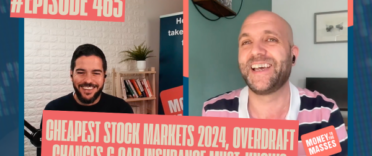The 112th episode of my weekly YouTube show where I discuss what is happening in investment markets and what to look out for. This week I talk about the ongoing impact of the Fed announcement and how it is affecting the reflation trade.
Each show lasts between 5-10 minutes and is aimed at DIY investors (including novices) seeking contemporary analysis to help them understand how investment markets work.
Subscribe to my YouTube channel to receive my weekly analysis of investment markets or alternatively, you can listen via my weekly Midweek Markets podcast below.
Midweek Markets weekly podcast
Other ways to watch, listen and subscribe
You can listen to other episodes and subscribe to the show by searching 'Money to the Masses' on Spotify or by using the following links:
Abridged transcript - Midweek Markets episode 112
Hello and welcome to the latest episode of Damien's midweek markets, the show where I talk about what's been going on in investment markets and what to look out for in the days and weeks ahead.
Inflation forecast to rise
Now the last week has been particularly interesting as the market has been trying to find a new narrative and we saw the beginnings of what looked like an aggressive unwinding of the reflation trade.
But before we get on to that, if we rewind back to last week, you will remember that the US Federal Reserve (the Fed) held a monetary policy meeting, after which it stated that future inflation was going to be higher than they previously predicted.
There was talk of the first interest rate rise occurring a year earlier (now in 2023) than previously thought. That shocked analysts and investors although in the immediate aftermath of the meeting equity markets took a sanguine view and remained largely unchanged. We did see a bond yields rally, especially on the 10 year US Treasury, which you would expect because in an inflationary environment bonds (fixed income) tend to perform poorly.
Reflation trade unwinds - growth stocks & bonds surge
Logic might dictate that the reflation trade would eventually kick into gear after the Fed’s announcement but that couldn't be further from the truth. In fact, after the market had digested the Fed’s more hawkish assessment of inflation, we eventually saw a rapid repricing of assets. From Thursday onwards we saw the yield on the 10 year US Treasury plummet and by the end of the week it fell down towards 1.35%, a three month low.
We also saw a rush into growth stocks and a rotation out of value stocks. So the complete reverse of the reflation trade. This meant that we saw a big rally in technology stocks at the end of last week. The reflation trade was in danger of completely falling apart.
If look at the $XLK ETF, which tracks an index of US technology stocks in the S&P 500, it rallied by 1.6% between Wednesday and the close of play on Friday.
If you look at the equivalent ETF for financial stocks ($XLF) it was down 3.1% over the same period. That's a huge difference of over 4% in just 48 hours.
So if you were invested in assets that were previously doing well in the reflation trade, you would have been licking your wounds in the last couple of days of last week. But remember $XLF is still up 25% year to date, so context is needed. The reflation trade may have been down but not completely out.
In contrast, if you were holding those assets that previously lagged during the reflation trade's success you would have been rejoicing last week. Growth stocks (such as technology stocks) held up particularly well.
The tech-heavy NASDAQ 100 was flat over the second half of last week following the Fed’s announcement Meanwhile the more cyclical/value focused Dow Jones fell -2.5% Energy stocks also struggled which dragged the energy-heavy FTSE 100 lower.
So why was the reflation trade fading, somewhat counterintuitively?
One reason could be a bout of possible profit-taking after the recent success of the reflation trade. Was there an element of portfolio rebalancing too? Was there a flight to safety into bonds amid concerns that the Fed could tighten monetary policy too soon and inadvertently crash the stock market?
The narrative the market seemed to settle upon was the idea that the Fed might ultimately tame inflation, by raising interest rates. That meant that the whole idea of inflation running hot (and a corresponding reflation trade to benefit from this) no longer made sense causing investors to exit the trade en masse.
Reflation trade bounces back
However, come Monday the market narrative had completely reversed once again and we saw a rally in all of the reflation trades that had slumped the previous week.
It meant that bond yields start to rally again. So after the 10 year US Treasury yield crashed down to 1.35% the previous week it rallied back to 1.5%. We saw financial stocks rally by 1-2% on Monday alone. On Monday, energy stocks also rallied by more than 2% while technology lagged behind.
It means that we are at a point where the market is trying to make sense of what's happening with inflation and what the Fed and other central banks might or might not do to tackle it.
In fact, just today, the Bank of England has announced that it intends to take a wait and see approach to inflation and isn’t rushing to withdraw any kind of monetary stimulus from the market in the UK. That means that interest rates are going to be kept at their all-time low for the foreseeable future which obviously caused the pound to weaken.
Equity markets seeking direction but making new highs
The market is now flip-flopping between this idea of buying reflation trade assets one day (so things like financials or the Dow Jones) and doing the complete opposite the next. So where are we at the moment, a week on from the Fed’s shock announcement? If you look at those reflation trade indicators that I mentioned earlier you will see that financials are still down 3% over the last week while technology stocks are up about 2.6%.
The daily price movements may have started to become less aggressive but there’s clearly still some contrast in short term performance. But look at the year to date numbers and financial stocks are still outpacing tech stocks by more than 12%. The 10 year US Treasury yield now sits around about 1.5% while equity markets are still at or near all-time highs. The NASDAQ even hit an all-time high this week.
Despite the rotations and sector repricing overall equity markets are still taking a sanguine view of things. The question becomes “is it too early to say the reflation trade is dead, and are we going to see a continued rotation back into growth stocks?” Or are we going to see the reflation trade get another lease of life? If you believed in the reflation story last week, what has really changed? The Fed still isn’t planning on altering interest rates for nearly two years. Plus, we’ve seen a couple of false dawns for growth stocks outperforming value stocks already this year.
Bitcoin crashes below $30,000
Another asset that it's worth mentioning before I finish is bitcoin because we've seen some aggressive price moves again, this week. The price crashed below the $30,000 level which is a key technical support line. If you use technical analysis, a strong move below $30,000 is likely to be negative for the future price of bitcoin and could spell more negative sentiment and a greater unwinding of its price. Staying above the $30,000 level is likely to be quite constructive and a more optimistic sign.
The reason behind this week's bitcoin crash was news of further clampdowns on cryptocurrencies by the Chinese authorities. But as I've mentioned in previous episodes of this show, bitcoin is a useful sentiment indicator for investment markets generally, even if you don't invest in the digital currency. When bitcoin's price rises it’s evidence of bullish spirits more widely but when it's falling then it’s indicative of negative sentiment in investment markets. So if we see bitcoin continue to crash, then that might be a bad omen for equity markets going forward as explained in episode 108 of this show.
To sum up, at the moment equity markets are either clinging to new all-time highs or within touching distance of them. Yet that doesn't mean they're going to stay there forever, especially as investors are still searching for a narrative to follow. Even when they do decide upon a new narrative they are now just as likely to choose a contradictory one an instant later.



